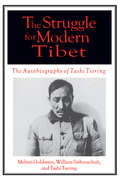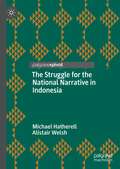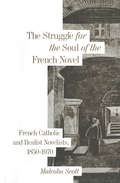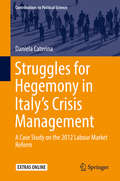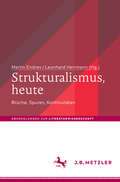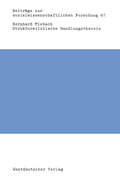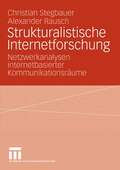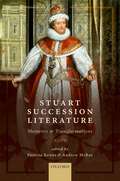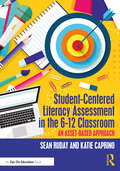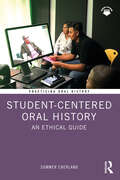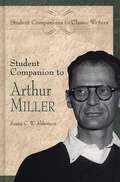- Table View
- List View
The Struggle for Modern Tibet: The Autobiography of Tashi Tsering (Mellen Studies In Education Ser. #Vol. 88)
by Melvyn C. Goldstein William R Siebenschuh Tashi TseringThis captivating autobiography by a Tibetan educator and former political prisoner is full of twists and turns. Born in 1929 in a Tibetan village, Tsering developed a strong dislike of his country's theocratic ruling elite. As a 13-year-old member of the Dalai Lama's personal dance troupe, he was frequently whipped or beaten by teachers for minor infractions. A heterosexual, he escaped by becoming a drombo, or homosexual passive partner and sex-toy, for a well-connected monk. After studying at the University of Washington, he returned to Chinese-occupied Tibet in 1964, convinced that Tibet could become a modernized society based on socialist, egalitarian principles only through cooperation with the Chinese. Denounced as a 'counterrevolutionary' during Mao's Cultural Revolution, he was arrested in 1967 and spent six years in prison or doing forced labor in China. Officially exonerated in 1978, Tsering became a professor of English at Tibet University in Lhasa. He now raises funds to build schools in Tibet's villages, emphasizing Tibetan language and culture.
The Struggle for the National Narrative in Indonesia
by Michael Hatherell Alistair WelshThis book offers a unique analysis of how political representatives construct ideas about the nation in contemporary Indonesian politics. In their struggle to define what the authors call the ‘national narrative’, would-be national leaders seek to develop a story about the nation’s past, present and future. These stories feature a unique plot, set of characters, and a moral that the political narrator hopes will resonate. In contemporary Indonesia, the authors assess two prominent national narratives: the technocratic and populist national narratives. The book concludes with an analysis that considers other potential sources of ideas about the nation, as well as the potential implications for domestic politics and Indonesian grand strategy.
The Struggle for the Past: How We Construct Social Memories (Worlds of Memory #6)
by Elizabeth JelinIn all societies—but especially those that have endured political violence—the past is a shifting and contested terrain, never fixed and always intertwined with present-day cultural and political circumstances. Organized around the Argentine experience since the 1970s within the broader context of the Southern Cone and international developments, The Struggle for the Past undertakes an innovative exploration of memory’s dynamic social character. In addition to its analysis of how human rights movements have inflected public memory and democratization, it gives an illuminating account of the emergence and development of Memory Studies as a field of inquiry, lucidly recounting the author’s own intellectual and personal journey during these decades.
Struggle for the Soul of the French Novel
by Michael ScottThis book describes the challenge to traditional Christian beliefs that was inherent in the very concept of literary Realism and presents the Catholic novel as a series of conscious readaptations of Realist techniques and models. Authors studied include Flaubert, Bernanos and Mauriac.
Struggles for Hegemony in Italy’s Crisis Management: A Case Study on the 2012 Labour Market Reform (Contributions to Political Science)
by Daniela CaterinaThis book investigates the struggles for hegemony, and a possible ‘crisis of crisis management’ at the core of Italy’s political economy. With a specific focus on the conflict over the 2012 labour market reform, the book also explores the country’s trajectory in the area of economic and social reproduction. It presents a framework for critical policy analysis that draws on cultural political economy and explores its potential synergies with complementary approaches such as historical materialist policy analysis and critical discourse analysis. Readers will gain an understanding of crisis dynamics in the aftermath of 2008, and insights into related political reactions. The book will also help them develop the analytical tools needed to make sense of these puzzling phenomena.
Strukturale Semantik: Methodologische Untersuchungen (Wissenschaftstheorie, Wissenschaft und Philosophie #4)
by Algirdas Julien GreimasStrukturalismus, heute: Brüche, Spuren, Kontinuitäten (Abhandlungen zur Literaturwissenschaft)
by Martin Endres Leonhard HerrmannWann beginnt, wann endet der Strukturalismus? Wie aktuell sind strukturalistische Grundannahmen, Methoden und analytische Praktiken? Aus der Sicht der Literatur-, Sprach- und Medienwissenschaft, der Kulturwissenschaft, der Narratologie und der Semiotik fragt der Band nach der Tradition, der Aktualität und der Relevanz strukturalistischer Denkmodelle. Deutlich wird dabei: Strukturalistische Grundannahmen reichen weiter in die Vergangenheit zurück und weiter in die Gegenwart hinein als vielfach angenommen.
Strukturalistische Handlungstheorie: Zum Verhältnis von soziologischer Theorie und empirischer Forschung im Werk Talcott Parsons’ (Beiträge zur sozialwissenschaftlichen Forschung #61)
by Bernhard MiebachStrukturalistische Internetforschung: Netzwerkanalysen internetbasierter Kommunikationsräume
by Christian Stegbauer Alexander RauschLange wurde angenommen, im Internet sei vieles von dem möglich, was ansonsten an sozialen Barrieren scheitert. Es wurde behauptet, Strukturen würden verschwinden, ebenso soziale Ungleichheiten, der Gegensatz von Stadt und Land, von Zentrum und Peripherie. Die Autoren zeigen anhand eines empirischen Forschungsprogramms der strukturalistischen Internetforschung, dass dies nicht der Fall ist. Mit Hilfe der Netzwerkanalyse zeigen sie, dass Strukturen entweder gar nicht verschwinden oder dort, wo dies der Fall ist, schon wieder neue Strukturen entstehen. Grundlage dieser Analysen sind Chatgroups, Mailinglisten oder die Zusammenarbeit von Menschen bei Wikipedia.
Strung Together: The Cultural Currency of String Theory as a Scientific Imaginary
by Sean MillerIn Strung Together: The Cultural Currency of String Theory as a Scientific Imaginary, Sean Miller examines the cultural currency of string theory, both as part of scientific discourse and beyond it. He demonstrates that the imaginative component of string theory is both integral and indispensable to it as a scientific discourse. While mathematical arguments provide precise prompts for physical intervention in the world, the imaginary that supplements mathematical argument within string theory technical discourse allows theorists to imagine themselves interacting with the cosmos as an abstract space in such a way that strings and branes as phenomena become substantiated and legitimized. And it is precisely this sort of imaginary—which Miller calls a scientific imaginary—duly substantiated and acculturated, that survives the move from string theory technical discourse to popularizations and ultimately to popular and literary discourses. In effect, a string theory imaginary legitimizes the science itself and helps to facilitate a virtual domestication of a cosmos that was heretofore remote, alien, and incomprehensible.
Stuart Academic Drama: An Edition of Three University Plays (Routledge Library Editions: Renaissance Drama)
by David L. RussellAlthough not much is known about the three Stuart plays in this edition, which was first published in 1987, we can ascribe them to one of the English universities, and each is indicative of a distinctly different influence on the Renaissance academic drama. Heteroclitanomalonomia is part of a minor subgenre referred to as the academic play. It demonstrates the predominance of language or rhetoric studies in the period and its very subject is of purely academic interest. Gigantomachia displays the continuing interest of the Renaissance in classical mythology. And A Christmas Messe follows a more homely tradition, a farcical personification of the mundane. This title will be of interest to students of English Literature, Drama and Performance.
Stuart Academic Drama: An Edition of Three University Plays (Routledge Library Editions: Renaissance Drama)
by David L. RussellAlthough not much is known about the three Stuart plays in this edition, which was first published in 1987, we can ascribe them to one of the English universities, and each is indicative of a distinctly different influence on the Renaissance academic drama. Heteroclitanomalonomia is part of a minor subgenre referred to as the academic play. It demonstrates the predominance of language or rhetoric studies in the period and its very subject is of purely academic interest. Gigantomachia displays the continuing interest of the Renaissance in classical mythology. And A Christmas Messe follows a more homely tradition, a farcical personification of the mundane. This title will be of interest to students of English Literature, Drama and Performance.
Stuart Succession Literature: Moments and Transformations
by Paulina Kewes Andrew McRaeMoments of royal succession, which punctuate the Stuart era (1603-1714), occasioned outpourings of literature. Writers, including most of the major figures of the seventeenth century from Jonson, Daniel, and Donne to Marvell, Dryden, and Behn, seized upon these occasions: to mark the transition of power; to reflect upon the political structures and values of their nation; and to present themselves as authors worthy of patronage and recognition. This volume of essays explores this important category of early modern writing. It contends that succession literature warrants attention as a distinct category: appreciated by contemporaries, acknowledged by a number of scholars, but never investigated in a coherent and methodical manner, it helped to shape political reputations and values across the period. Benefitting from the unique database of such writing generated by the AHRC-funded Stuart Successions Project, the volume brings together a distinguished group of authors to address a subject which is of wide and growing interest to students both of history and of literature. It illuminates the relation between literature and politics in this pivotal century of English political and cultural history. Interdisciplinary in scope, the volume will be indispensable to scholars of early modern British literature and history as well as undergraduates and postgraduates in both fields.
Stuart Succession Literature: Moments and Transformations
Moments of royal succession, which punctuate the Stuart era (1603-1714), occasioned outpourings of literature. Writers, including most of the major figures of the seventeenth century from Jonson, Daniel, and Donne to Marvell, Dryden, and Behn, seized upon these occasions: to mark the transition of power; to reflect upon the political structures and values of their nation; and to present themselves as authors worthy of patronage and recognition. This volume of essays explores this important category of early modern writing. It contends that succession literature warrants attention as a distinct category: appreciated by contemporaries, acknowledged by a number of scholars, but never investigated in a coherent and methodical manner, it helped to shape political reputations and values across the period. Benefitting from the unique database of such writing generated by the AHRC-funded Stuart Successions Project, the volume brings together a distinguished group of authors to address a subject which is of wide and growing interest to students both of history and of literature. It illuminates the relation between literature and politics in this pivotal century of English political and cultural history. Interdisciplinary in scope, the volume will be indispensable to scholars of early modern British literature and history as well as undergraduates and postgraduates in both fields.
Student Activism in 1960s America: Stories from Queens College (Palgrave Studies in the History of Social Movements)
by Magnus O. BasseyThis book sheds light on the untold stories of individual student activists at Queens College, New York City, during the 1960s. Against the backdrop of the ongoing Vietnam War and the assassination of President John F. Kennedy, some Americans began to lose faith in their government. Based on injustices that students saw in their campuses, in the country, and in the world at large, they began to question their political leaders. Students organized their discontents over three major issues: civil rights, free speech, and anti-war sentiments. Their protests involved direct actions such as sit-ins, marches, picketing, and boycotts. At Queens College (QC), as the students moved away from the repressive McCarthy era of the 1950s, they began to confront and challenge those in power at the college in the 1960s. The defining characteristic of this break from the past was a student strike in 1961 in objection to the ban of controversial speakers who had been invited to campus by student clubs. The student strike of 1961 gave the activists among them a direct and immediate way to fight power on campus and to fight racism and discrimination. The author argues that student movements cannot be attributed to a single explanation, and therefore, he focuses on individual historical contexts, presenting first-person narratives from the actual participants, and tells their stories in their own voices, from their own records, and from the documents they left behind. The book identifies the QC student activists of the 1960s, exploring how and why they became activists; their activities; their achievement as activists; and what motivated them to think that they could make history themselves by confronting racism. It provides an intimate look at the students’ lives and their social justice journey, beginning at Queens College and as they moved into their careers.
Student-Centered Literacy Assessment in the 6-12 Classroom: An Asset-Based Approach
by Sean Ruday Katie CaprinoIn this practical and accessible book, you’ll learn how to create equitable and meaningful assessments in your instruction through an inquiry-based approach. Ruday and Caprino reimagine what asset-based literacy assessments can be and what they look like in practice by understanding that effective, asset-based literacy assessments must center on students: they must incorporate students’ unique perspectives, ideas, and experiences in meaningful and relevant ways. Instead of using assessments that focus on identifying what students don’t know, the practices presented in this book provide authentic opportunities for students to use what they do know to demonstrate their knowledge of important literacy concepts. The book is organized into three easy-to-use parts that cover: Key concepts of asset-based assessment Specific ways that these practices can be put into action Putting it all together in your own education context. A great resource for busy teachers, this book features a guide for teachers to use during professional development book studies and ready-to-implement templates when applying the assessment practices described in the book.
Student-Centered Oral History: An Ethical Guide (Practicing Oral History)
by Summer CherlandStudent-Centered Oral History explores the overlaps of culturally relevant teaching, student-centered teaching, and oral history to demonstrate how this method empowers students, especially those from historically underrepresented communities. With tangible tools like lesson plans and reflection sheets, available to download as eResources from the book's website, each interactive chapter is applicable to classrooms and age groups across the globe. Educators from all levels of experience will benefit from step-by-step guides and lesson plans, all organized around guiding questions. These lessons coach students and educators from start to finish through a student-centered oral history. Background research, historical context, cultivating a culture of consent, analysis, promotion, and gratitude are among the many lessons taught beyond writing questions and interviewing. With a specific focus on the ethics influencing a teacher’s role as guide and grader of a student-centered oral history, this book also highlights successful approaches across the world of students and teachers discovering oral history. These examples reveal how student-centered oral history empowers academic achievement, radicalizes knowledge, develops relationships, and promotes community engagement. This book is a useful tool for any students and scholars interested in oral history in an educational setting.
Student-Centered Oral History: An Ethical Guide (Practicing Oral History)
by Summer CherlandStudent-Centered Oral History explores the overlaps of culturally relevant teaching, student-centered teaching, and oral history to demonstrate how this method empowers students, especially those from historically underrepresented communities. With tangible tools like lesson plans and reflection sheets, available to download as eResources from the book's website, each interactive chapter is applicable to classrooms and age groups across the globe. Educators from all levels of experience will benefit from step-by-step guides and lesson plans, all organized around guiding questions. These lessons coach students and educators from start to finish through a student-centered oral history. Background research, historical context, cultivating a culture of consent, analysis, promotion, and gratitude are among the many lessons taught beyond writing questions and interviewing. With a specific focus on the ethics influencing a teacher’s role as guide and grader of a student-centered oral history, this book also highlights successful approaches across the world of students and teachers discovering oral history. These examples reveal how student-centered oral history empowers academic achievement, radicalizes knowledge, develops relationships, and promotes community engagement. This book is a useful tool for any students and scholars interested in oral history in an educational setting.
Student Companion to Arthur Miller (Student Companions to Classic Writers)
by Susan C. AbbotsonThis critical introduction to Arthur Miller provides an indispensable aid for students and general readers to understand the depth and complexity of some of America's most important dramatic works. Beginning with a discussion of his life, this work traces not only Miller's theatrical career, but his formulative experiences with the Great Depression, the Holocaust, and the House Un-American Activities Committee. Detailed discussions of eight important plays are organized around the social and moral themes Miller derived from such events; these themes are evident in such works as Death of A Salesman, The Crucible, A View from the Bridge, and All My Sons. By placing Miller, within the context of his times, this discussion reveals how he was influenced by and reacted to the major events in his own life and in American culture. Analysis of his more recent works such as The American Clock, Broken Glass and The Ride Down Mt. Morgan illustrate the consistency of Miller's strong moral vision, and his continuing innovative contributions to American theatre.A fascinating biographical chapter takes readers from Miller's childhood, through the Depression years, through three marriages; and from his theatrical apprenticeship, to eventual fame and critical acclaim for his plays and other literary and cinematic projects. The literary heritage chapter outlines Miller's literary and dramatic precursors, and considers the major aspects of his dramatic impact. The six chapters discussing his major plays are systematically presented to allow the reader to easily grasp the intricacies of their plots, characterizations, stylistic devices, and themes. In addition, each chapter offers a view of the social and/or historical context that influenced the plays' thematic development, as well as an alternate critical reading that demonstrates the richness of Miller's work. Lastly, the bibliography provides information on Miller's published works, including his screenplays and essays, biographical information, selected general criticism, and both contemporary reviews and critical studies of the plays discussed.
Student Companion to Charles Dickens (Student Companions to Classic Writers)
by Ruth GlancyCharles Dickens was the most popular writer of his age and is still considered one of the world's greatest novelists. This well-written study surveys his unusual and prolific life, relating his fiction writings to his concerns and active involvement with social conditions of early Victorian England. Glancy skillfully takes the reader back in time to appreciate the historical settings that inspired works like Oliver Twist, Great Expectations, and A Tale of Two Cities. An entire chapter is devoted to each of these works, as well as to David Copperfield, Hard Times, the Christmas books, and the early novels from The Pickwick Papers to Martin Chuzzlewit. In each chapter Glancy's analysis of plot, style, and character development bring these imaginative stories to life for the reader. This book examines Dickens's keen understanding of human nature and draws out the themes that make works such as A Christmas Carol as beloved today as when first written.This companion to Dickens will aid students in understanding the social context and literary genius of one of the greatest Victorian novelists. The thorough biographical chapter traces Dickens' life from his childhood through the development of his multi-faceted literary career. The literary heritage chapter examines the tremendous influence Dickens exerted on writing then and now. This volume surveys all of Dickens' work and provides in-depth readings of five of his novels and his Christmas works. The series format makes analysis of setting, plot, character development, and themes for each work accessible to students. The alternate critical perspectives enhance readers' understanding of Dickens' work. The selected bibliography and reviews cover both original and contemporary sources.
Student Companion to Edgar Allan Poe (Student Companions to Classic Writers)
by Professor or Dr. Tony MagistraleThe contributions of Edgar Allan Poe have withstood the test of time; his best poems and fiction are more popular and carry greater significance now than they did during his own era. This highly readable introduction to the life, times, and major works of Poe offers fresh interpretations of timeless masterpieces like The Raven and The Purloined Letter. Carefully considering important thematic elements as well as genre, this book organizes the works of Poe into four significant groupings: the poetry, Vampiric love stories, tales of psychological terror, and the detective stories. Close readings are given for a selection of the most important works that represent Poe's canon of writings, including the chilling Tell Tale Heart and The Black Cat.This introductory study to Edgar Allan Poe begins with a concise biographical chapter that explores Poe's troubled experiences. The Literary Heritage chapter chronicles Poe's influence on other writers, artists, and filmmakers who followed. This work examines the major poems from Poe's canon, with special attention to those works that are most often taught and anthologized. Poe's most famous tales of terror and revenge are juxtaposed because they all revolve around murders and the elements of terror associated with the act of killing. Likewise, his love stories are brought together in a chapter that deals with vampirisim and gender. The final chapter, The Origins of the Detective Tale, examines Poe's tales of ratiocination, and traces the evolution of many popular culture super sleuths to Poe's Dupin. A selective bibliography of biographical and critical works on Poe, including contemporary reviews, completes this thorough volume. Students, general readers, and fans of all things Gothic will enjoy the fascinating insights this volume offers.
Student Companion to Edith Wharton (Student Companions to Classic Writers)
by Melissa McFarland PennellOne of the most accomplished American writers of the early 20th century, Edith Wharton achieved both critical recognition and popular acclaim. This Student Companion provides an introduction to Wharton's fiction. Beginning with her life and career, the volume places Wharton in the context of her times, focusing on how she was shaped by the culture of wealth and privilege into which she was born. Her struggle to resist the demands of her social world paralleled her characters' lives and contributed to the power of her writing. Included are an in-depth discussion of her writing, along with analyses of thematic concerns, character development, historical context, and plot. A close critical reading covers each of her major works, with a full chapter devoted to each: The House of Mirth (1905), Ethan Frome (1911), Summer (1917), The Age of Innocence (1920), and her two novellas, Madame de Treymes (1907) and The Old Maid (1924).Another chapter addresses Wharton's short stories and considers some of her most famous and anthologized tales, such as The Other Two and Roman Fever. This companion is ideal for students who are reading Wharton for the first time, or for general readers who are seeking a greater understanding of her writing. A select bibliography offers suggestions for further reading about Wharton and includes criticism and contemporary reviews of her work.
Student Companion to Elie Wiesel (Student Companions to Classic Writers)
by Sanford SternlichtSince it was written nearly 50 years ago, Night (1958) has changed world perception of the Holocaust experience. Wiesel's oeuvre, including Holocaust narratives such as Dawn (1961), novels, essays, tales, and plays, has also altered the critical and aesthetic landscape through which we view literature, placing themes of religious identity, hope, survival, devotion to family, and humanity ahead of distinctions of fiction and nonfiction. This volume offers critical analysis of all of Wiesel's major writings, with full chapters on Night, Dawn, The Oath, and four other full-length works. His most recent five novels, including The Testament (1980) and Twilight (1987), are also covered. Plot, character development, thematic concerns, and style are discussed, as are historical contexts and alternate critical perspectives.This volume is an indispensable tool for students, whether they are encountering Night for the first time, revisiting Wiesel's literary contributions, or discovering the author's recent works, such as The Judges (1999). A biographical section relates the tragic events of Wiesel's life to his inspirational writings. A literary heritage chapter offers an overview of his achievements and situates his works within the Western literary tradition and the historical and religious frameworks. A separate chapter covers Wiesel's nonfiction writings, including his most important essays, tales, and studies. A bibliography of selected sources is included.
Student Companion to Ernest Hemingway (Student Companions to Classic Writers)
by Lisa TylerThe fully-lived, yet tragically ended life of Ernest Hemingway has attracted nearly as much attention as his extensive canon of writings. This critical study introduces students to both the man and his fiction, exploring how Hemingway confronted in his own life the same moral issues that would later create thematic conflicts for the characters in his novels. In addition to the biographical chapter which focuses on the pivotal events in Hemingway's personal life, a literary heritage chapter overviews his professional developments, relating his distinctive style to his early years as a journalist. With clear concise analysis, students are guided through all of Hemingway's major works including The Sun Also Rises (1926), A Farewell to Arms (1929), For Whom the Bell Tolls (1940), and The Old Man and the Sea (1952). Full chapters are also devoted to examining his collections of short fiction, the African Stories, and the posthumous works.Each chapter carefully examines the major literary components of Hemingway's fiction with plot synopsis, analysis of character development, themes, settings, historical context, and stylistic features. Alternate critical readings are also given for each of the full length works. An extensive bibliography citing all of Hemingway's writings as well as biographical sources, general criticism, and contemporary reviews will help students understand the scope of Hemingway's contributions to American Literature.
Student Companion to Eugene O'Neill (Student Companions to Classic Writers)
by Steven F. Ph.D.Eugene O'Neill is the only American dramatist ever to have received the Nobel Prize for Literature. He wrote over 50 plays; a number are virtually unknown by the general public; several are considered classics of the American stage; all of them demonstrate, in one way or another, how O'Neill challenged the conventional boundaries of the drama of his time and thereby paved the way for modern American theatre. This volume will provide guides to eight of O'Neill's plays that are most often studied in schools and colleges: The Hairy Ape, Anna Christie, The Emperor Jones, Desire Under the Elms, Ah, Wilderness!, The Iceman Cometh, Long Day's Journey Into Night, and A Moon for the Misbegotten. More than almost any other author in any fictional genre, O'Neill's works are highly autobiographical. The love/hate relationships he had with the members of his own family resonate throughout his dramatic works. The son of an alcoholic and a morphine addict, he struggled with chemical dependency throughout his life, but determined to be an artist or nothing, he eventually gave up drinking and fulfilled his artistic ambitions, transforming the traumatic experiences of his life into compelling drama. O'Neill's drama provides insights into the complexities of human behavior and raises questions about the forces, both external and internal, that shape human lives.
